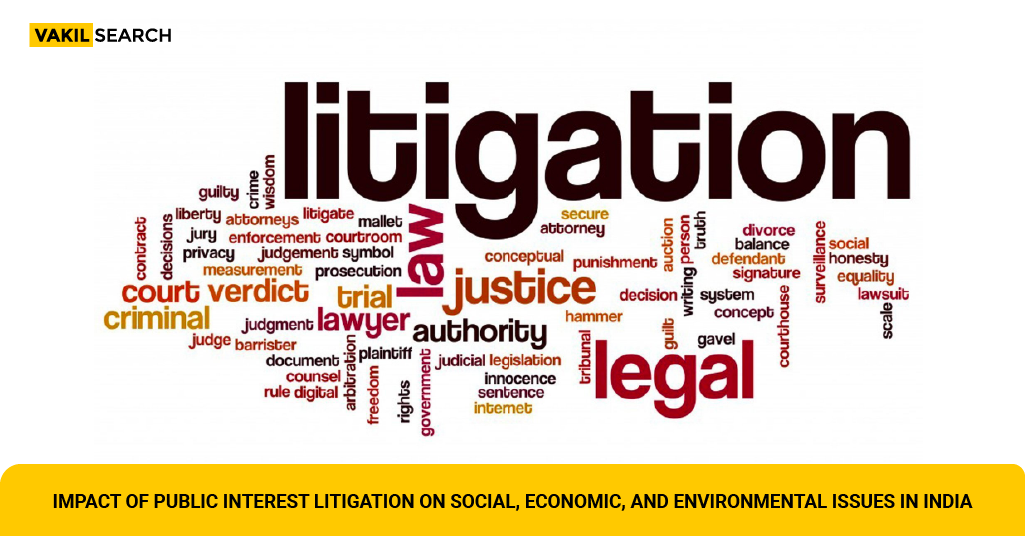Public Interest Litigation (PIL) is a mechanism for the common people to seek legal recourse to address issues of public concern. However, there have been criticisms and challenges that have emerged in its implementation in India.
Overview on PIL and Its Impact in India
PIL has played a significant role in bringing about social justice and has been used to challenge corruption, discrimination, and environmental degradation. PIL has its roots in the Indian Constitution’s fundamental rights and directive principles of state policy, which mandate the state to ensure social justice and equality. The Supreme Court of India recognised PIL in the 1980s and opened up a new avenue for citizens to seek redressal of their grievances. PIL allows citizens to approach the courts on behalf of the public interest, even if they are not personally affected by the issue.
Challenges of PIL in India
Misuse of PIL
One of the major challenges of PIL is its misuse by vested interests, including political parties and individuals with malicious intent. PIL has been used as a tool for settling personal scores or advancing private interests. The courts have also been criticised for entertaining frivolous PILs, which not only waste judicial time but also dilute the credibility of the PIL.
Lack of Access to Justice
The PIL process can be a costly affair, and this poses a challenge to those who seek to use it for social justice. There is also a lack of awareness among the general public about PIL and its benefits. Consequently, a large section of society is unable to access the PIL mechanism, which undermines its potential as an instrument of social change.
Overburdening of the Judiciary
The increasing number of PILs has put a burden on the judiciary, which is already struggling to handle the backlog of cases. The frequent filing of PILs has led to delays in the disposal of cases, which has resulted in a lack of faith in the judicial system. The judiciary has also been criticised for overstepping its boundaries and interfering with the functioning of the executive and legislative branches of government.
Limited Effectiveness
PIL has been successful in bringing about social and environmental reforms, but its effectiveness in enforcing fundamental rights has been limited. Many PILs remain unresolved for years, and the relief granted may not always be adequate. Moreover, PIL cannot be used as a substitute for systemic reforms and policymaking.
Important Features of PIL in India
Anyone Can File a PIL
PIL can be filed by any individual or group, including NGOs and social activists, on behalf of the public. There is no requirement for the petitioner to have a direct or personal interest in the matter.
Wide Ambit of Issues
PIL can be filed on a wide range of issues that affect the public, including social, economic, and environmental issues. Public Interest Litigation can be used to challenge unconstitutional laws, to bring about systemic reforms, and to hold the government accountable for its actions.
No Court Fees
There is no court fee for filing a PIL. This makes it an affordable mechanism for seeking justice for those who cannot afford expensive legal fees.
Quicker Resolution
PILs are given priority by the courts and are often heard and resolved quickly. This has helped in providing speedy justice in matters that affect the public interest.
Remedies Granted
The courts have wide-ranging powers to grant remedies in PILs, including directions to the government to take necessary action, monetary compensation, and even imprisonment of officials who fail to comply with court orders.
Preventive and Proactive
PIL is preventive and proactive in nature. It enables the courts to take action before harm is caused to the public interest. PIL has been used to prevent environmental damage, protect the rights of the marginalised, and ensure transparency in governance.
Advantages of Public Interest Litigation (PIL)
- Promotes accountability among public bodies by ensuring they act reasonably within their powers and make precise decisions
- Expands the interpretation of laws, aiding judges in understanding legislation and evolving legal frameworks
- Provides a platform for marginalised voices to raise significant issues and advocate for their rights
- Raises awareness of critical public problems through media coverage and public debates
- Facilitates affordable access to justice, enabling citizens to address public issues through nominal court fees
- Focuses attention on broader public concerns such as consumer welfare, environmental protection, and human rights.
Disadvantages of Public Interest Litigation (PIL)
- Risk of clogging the judicial system with petitions lacking significant public interest
- Adds to the burden of an already overloaded Indian Judiciary due to pending cases
- Potential for abuse, as PIL may be misused for personal agendas rather than genuine public concerns, leading to ‘private interest litigation’
- Challenges in the effective enforcement of court judgments, undermining the successful implementation of PIL outcomes.
Examples of Public Interest Litigation Cases
Here are a few instances of famous public interest litigation cases in India:
Hussainara Khatoon vs. State of Bihar case
This landmark case marked the inception of PIL in India, shedding light on the dire conditions faced by prisoners and undertrials.
Vishaka vs. State of Rajasthan
This case addressed workplace sexual harassment, leading to the establishment of the Vishaka Guidelines in 1997. These guidelines defined sexual harassment, outlined preventive measures, and provided guidance on reporting incidents.
M.C. Mehta vs. Union of India
This case focused on pollution in the Ganges basin, condemning the release of untreated sewage into the river by Kanpur’s tanneries. The judgment emphasised the importance of sustainable development and issued directives to mitigate water and air pollution in the region.
Parmanand Katara vs. Union of India
Filed to enable hospitals to provide emergency medical care to accident victims without waiting for police investigations, this case mandated immediate medical assistance to road accident victims by both public and private healthcare facilities.
How Much Money is Required to File a PIL in India?
The fee for filing a PIL in court is ₹50 for each respondent. However, the cost of presenting the case in court varies depending on the advocate chosen by the petitioner.
Conclusion
PIL has been a powerful tool for social justice in India. However, its misuse, lack of access to justice, overburdening of the judiciary, and limited effectiveness are significant challenges that need to be addressed. The judiciary needs to be more vigilant in screening frivolous PILs and ensuring that the PIL process is not abused. There is also a need to create awareness about PIL and make it accessible to all sections of society. Finally, the judiciary needs to strike a balance between its interventionist role and the separation of powers doctrine to avoid overstepping its constitutional boundaries.
Frequently Asked Questions
What is a PIL in law?
A Public Interest Litigation (PIL) in law allows individuals or groups to initiate legal action in the interest of the public or society. It enables citizens to seek justice for matters affecting public welfare, such as environmental protection or human rights violations.
What is a PIL under Article 32?
Under Article 32 of the Indian Constitution, PIL serves as a constitutional remedy for enforcing fundamental rights. It empowers the Supreme Court to address violations of fundamental rights directly, making it a crucial tool for protecting citizens' rights and promoting justice and accountability.
Who can file a PIL in court?
Any Indian citizen or organisation has the right to submit a public interest litigation petition to either the Supreme Court under Article 32 or the High Courts under Article 226 of the Constitution of India.
What are PIL types?
Public Interest Litigation (PIL) comprises two categories: Representative Social Action and Citizen Social Action.
Can I file a PIL without a lawyer?
Yes, While it's possible for individuals to submit a PIL without engaging a lawyer, it's recommended to seek legal assistance given the intricate nature of legal procedures and PIL cases. This ensures proper representation and compliance with court protocols and requirements.
Can a lawyer file a PIL?
It's evident that any individual can initiate a PIL on behalf of a group of affected individuals. However, whether it's permitted or not depends on the specifics of each case
Can I file a PIL in the high court?
As per the Indian Constitution, individuals can submit a petition under Article 226 to a High Court or under Article 32 to the Supreme Court of India. To file a Writ Petition/PIL, the first step involves reaching out to a public interest lawyer or organisation to initiate the case.
How can a PIL be rejected?
If the petitioner fails to explore all legal avenues or provides incomplete or inaccurate information in the PIL, the court might dismiss it and suggest alternative remedies.
What is the eligibility criteria for PIL?
According to Public Interest Litigation (PIL), individuals or social organisations with altruistic motives have the ability to petition the court to enforce the rights of individuals or groups who, due to poverty, lack of knowledge, or social and economic disadvantages, are unable to seek legal remedies on their own.
Can we file PIL online?
Submitting a Public Interest Litigation (PIL) can seem overwhelming, particularly when dealing with legal procedures. Yet, thanks to technological progress, filing a PIL online in the esteemed High Court and Supreme Court has become feasible, enhancing convenience and accessibility for the public.
What is an example of PIL?
Naina Kapoor took the initiative to file a Public Interest Litigation (PIL) in the Supreme Court, aiming to address workplace sexual harassment. The court's ruling acknowledged sexual harassment as a breach of fundamental constitutional rights outlined in Articles 14, 15, and 21. Additionally, the judgment included directives for preventing sexual harassment.
Read more,










